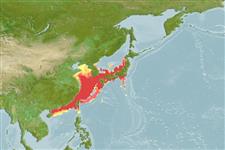Environment: milieu / climate zone / rango de profundidad / distribution range
Ecología
marino bentopelágico; rango de profundidad 0 - 370 m (Ref. 54713). Tropical; 42°N - 19°N, 111°E - 141°E (Ref. 54713)
Western Pacific: Japan and the East China Sea. Reported from Hong Kong (Ref. 12083).
Length at first maturity / Tamaño / Peso / Age
Madurez: Lm ?, range 15 - ? cm
Max length : 30.0 cm TL macho / no sexado; (Ref. 2272)
Short description
Claves de identificación | Morfología | Morfometría
Espinas dorsales (total) : 6 - 7; Radios blandos dorsales (total) : 27 - 33; Espinas anales: 3; Radios blandos anales: 24 - 28. Body whitish ; in young it is pale brown or blackish brown. Spines of dorsal fin short, not separated from soft-rayed portion (Ref. 41299).
Body shape (shape guide): short and / or deep; Cross section: compressed.
Juveniles are associated with jellyfish, and can occur in small groups. Adults become bottom-dwellers (Ref. 128523). Tasty food fish (Ref. 559).
Life cycle and mating behavior
Madurez | Reproducción | Puesta | Huevos | Fecundidad | Larva
Bykov, V.P., 1983. Marine Fishes: Chemical composition and processing properties. New Delhi: Amerind Publishing Co. Pvt. Ltd. 322 p. (Ref. 4883)
IUCN Red List Status (Ref. 130435: Version 2025-1)
Threat to humans
Harmless
Human uses
Pesquerías: comercial
Herramientas
Special reports
Download XML
Fuentes de Internet
Estimates based on models
Preferred temperature (Referencia
123201): 11.1 - 23.2, mean 18.4 °C (based on 218 cells).
Phylogenetic diversity index (Referencia
82804): PD
50 = 0.5156 [Uniqueness, from 0.5 = low to 2.0 = high].
Bayesian length-weight: a=0.01413 (0.00852 - 0.02342), b=3.07 (2.93 - 3.21), in cm total length, based on LWR estimates for this species & (Sub)family-body (Ref.
93245).
Nivel trófico (Referencia
69278): 4.0 ±0.28 se; based on food items.
Resiliencia (Referencia
120179): Medio, población duplicada en un tiempo mínimo de 1.4-4.4 años (Assuming tm=1).
Prior r = 0.49, 95% CL = 0.32 - 0.73, Based on 1 data-limited stock assessment.
Fishing Vulnerability (Ref.
59153): Low to moderate vulnerability (27 of 100).
🛈
Climate Vulnerability (Ref.
125649): Moderate to high vulnerability (47 of 100).
🛈
Nutrients (Ref.
124155): Calcium = 110 [63, 258] mg/100g; Iron = 1.09 [0.59, 1.92] mg/100g; Protein = 17.3 [15.5, 19.2] %; Omega3 = 0.231 [0.119, 0.434] g/100g; Selenium = 87 [40, 201] μg/100g; VitaminA = 26.7 [8.1, 99.1] μg/100g; Zinc = 0.935 [0.613, 1.413] mg/100g (wet weight); based on
nutrient studies.
